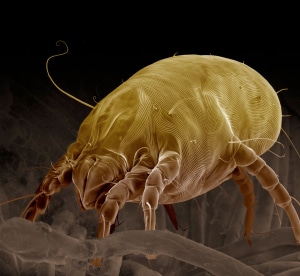The common house dust mite, dermatophagoides pteronyssinus, and his/her relatives are common throughout temperate climates worldwide. Whilst science continues to learn more over time, we can use basic logic to find our way. There is little doubt that for allergy sufferers, an excess of dust mites in their environment exacerbates their symptoms. So this article aims to keep things simple and practical. Because understanding the precise science of dust mites is still an evolving practice and can get mighty confusing.
So, put simply, dust mites live wherever we live. They feed off our dead skin scales and those of our pets, too. So wherever we are, there they will be too. This isn’t really a big problem if their populations do not reach a critical mass. But when house dust mite populations rage unchecked, there can be trouble – especially for those with sensitivities. You see, if there is adequate food, house dust mites can repopulate at the rate of 30 new dust mites per month. And it doesn’t take long for that reproduction rate to go exponential.

Dust mites inhabit homes, feeding on the shed skin flakes of the inhabitants. Their faeces produce extremely fine particle dust that can precipitate asthma and other respiratory problems. They can be present in huge numbers in pillowcases and bed sheets.
Reducing house dust-mite populations – the basics
And so the solution is to do all you can to reduce their populations, which is not as hard as you may think. Firstly, know that most skin-shedding happens in and around our beds. So make sure you have a mattress protector. To keep the dust mites at bay, reduce the amount of food they have. Clean your house regularly. But do so wisely with a focus on the fine particles of dust. Human skin flaked, and the subsequent cast skins and faecal matter from the dust mites are tiny. So tiny, in fact, that it actually goes airborne with traditional cleaning methods. To understand the science of why dost floats and how to reduce the dreaded “dust-drop” effect.
Make sure your vacuum cleaner has a HEPA filter. Also, consider an anti-bacterial air filter and even an ioniser in your home. These will help to capture the airborne dust, allergens, and pollutants that make allergy sufferers feel so generally off. For more information, please visit the 1800 CLEANER blog and please ask any further questions you have for an immediate answer.

